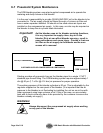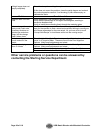
Page 86 of 118 SGB Batch Blender with Mitsubishi Controller
Problem Possible solution
Check batch weight setting in the recipe menu. See the setup chapter for
more information.
Check the load cells and weigh hopper mounting for binding, etc.
Check to see that a pellet has not lodged under a load cell.
Check the ingredient supply hoppers to verify proper ventilation. If a
vacuum receiver has a leaking flapper valve and the supply hopper is not
vented, the blender computer can learn inaccurately and cause an overfill
condition on the next few cycles.
Weigh hopper occasionally
overfills.
Check the load cell connections to the panel.
Check the mix timer setting. This problem is normally due to over mixing.
See the mix timer section in the setup chapter. Reduce the time until the
problem is corrected.
Check the mixer drive to ensure that the agitator is turning properly.
Material tends to separate
in the mixing chamber.
Check the high level switch in the mixer to lower the level slightly.
Material sticks to the
flapper of the weigh
hopper and is not dumped.
Increase the Dump Cycles setting in Mixer and Dump Setup.
Too much material
remains in the mixer.
Increase the Mixer Dump Time in Mixer and Dump Setup.
The material is not being
mixed thoroughly.
Increase the Mixing Time in Mixer and Dump Setup. Actually if you over
mix material, you can have the same problem. If you have the blender
set for “Continuous Mixing” then change it to “Timed Mixing” and adjust
the Mixing Time appropriately.
Check the blender’s scale calibration and verify that the batch hopper is
not overfilling. If the hopper is overfilling, adjust your batch size. If this is
correct, then you are probably not accounting for material scrap or other
items in your process.
Recorded Inventory Totals
don’t match what I’ve
actually used
Some error can be introduced by not weighing every batch. Check the
Recipe Page.
Max Hopper Weight
Exceeded Alarm continues
to re-occur.
Stop the Blender and then Start it again. This causes the blender to
perform an automatic feeder calibration. If this doesn’t fix it, then
manually perform feeder calibrations and retest.
The blender intermittently dumps a batch of material with one or more of
the components incomplete.
Check the recipe information; ensure that both the percentages and batch
size are set properly.
Check the status of the alarm flags & Feeder Setup to ensure that all of
the feeders are set to Retry. In addition, if the blender is configured for
timed batches then this can cause error.
Blender occasionally
dumps an incorrect
batch.
Check supply hopper ventilation to prevent problem associated with leaky
vacuum receiver flappers.
Check the mixer high-level switch sensitivity. When the sensor is covered
by material, the indicator lamp on the back of the switch should be lit. To
adjust the sensitivity, use the small adjustment screwdriver that was
provided with the blender. The adjustment pot is located on the back of
the sensor. Rotate clockwise to increase the sensitivity (less material in
front of the switch to actuate it). Rotate counter clockwise to decrease the
sensitivity (more material covering the switch).
Blender keeps dumping
after mixer is full.
Check the mixer high-level sensor connection to the control panel.
Check the mixer high-level switch sensitivity. Fines may have coated the
level switch; it needs readjustment.
Check the proximity switch connection.
Make sure that the recipe is correct.
Blender will not batch with
empty mixer.
Check batch size.


















